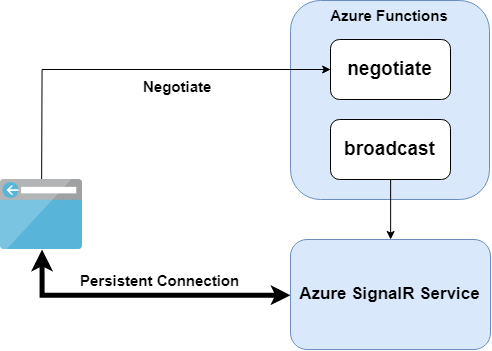Note
Access to this page requires authorization. You can try signing in or changing directories.
Access to this page requires authorization. You can try changing directories.
In addition to the classic client/server pattern, Azure SignalR Service provides a set of REST APIs to help you integrate real-time functionality into your serverless architecture.
Note
Azure SignalR Service supports using REST APIs only to manage clients connected through ASP.NET Core SignalR. Clients connected through ASP.NET SignalR use a different data protocol that's not currently supported.
Typical serverless architecture with Azure Functions
The following diagram shows a typical serverless architecture that uses Azure SignalR Service with Azure Functions.

- The
negotiatefunction returns a negotiation response and redirects all clients to Azure SignalR Service. - The
broadcastfunction calls the REST API for Azure SignalR Service. Azure SignalR Service broadcasts the message to all connected clients.
In a serverless architecture, clients have persistent connections to Azure SignalR Service. Because there's no application server to handle traffic, clients are in LISTEN mode. In that mode, clients can receive messages but can't send messages. Azure SignalR Service disconnects any client that sends messages because it's an invalid operation.
You can find a complete sample of using Azure SignalR Service with Azure Functions in this GitHub repository.
Implement the negotiation endpoint
You should implement a negotiate function that returns a redirect negotiation response so that clients can connect to the service.
A typical negotiation response has this format:
{
"url": "https://<service_name>.signalr.azure.cn/client/?hub=<hub_name>",
"accessToken": "<a typical JWT>"
}
The accessToken value is generated through the same algorithm described in the authentication section. The only difference is that the aud claim should be the same as url.
You should host your negotiation API in https://<hub_url>/negotiate so that you can still use a SignalR client to connect to the hub URL. Read more about redirecting clients to Azure SignalR Service in Client connections.
REST API versions
The following table shows all supported REST API versions. It also provides the Swagger file for each API version.
| API version | Status | Port | Documentation | Specification |
|---|---|---|---|---|
20220601 |
Latest | Standard | Article | Swagger file |
1.0 |
Stable | Standard | Article | Swagger file |
1.0-preview |
Obsolete | Standard | Article | Swagger file |
The following table lists the available APIs.
| API | Path |
|---|---|
| Broadcast a message to all clients connected to target hub | POST /api/v1/hubs/{hub} |
| Broadcast a message to all clients belong to the target user | POST /api/v1/hubs/{hub}/users/{id} |
| Send message to the specific connection | POST /api/v1/hubs/{hub}/connections/{connectionId} |
| Check if the connection with the given connectionId exists | GET /api/v1/hubs/{hub}/connections/{connectionId} |
| Close the client connection | DELETE /api/v1/hubs/{hub}/connections/{connectionId} |
| Broadcast a message to all clients within the target group | POST /api/v1/hubs/{hub}/groups/{group} |
| Check if there are any client connections inside the given group | GET /api/v1/hubs/{hub}/groups/{group} |
| Check if there are any client connections connected for the given user | GET /api/v1/hubs/{hub}/users/{user} |
| Add a connection to the target group | PUT /api/v1/hubs/{hub}/groups/{group}/connections/{connectionId} |
| Remove a connection from the target group | DELETE /api/v1/hubs/{hub}/groups/{group}/connections/{connectionId} |
| Check whether a user exists in the target group | GET /api/v1/hubs/{hub}/groups/{group}/users/{user} |
| Add a user to the target group | PUT /api/v1/hubs/{hub}/groups/{group}/users/{user} |
| Remove a user from the target group | DELETE /api/v1/hubs/{hub}/groups/{group}/users/{user} |
| Remove a user from all groups | DELETE /api/v1/hubs/{hub}/users/{user}/groups |
Using the REST API
Authentication via AccessKey in Azure SignalR Service
In each HTTP request, an authorization header with a JSON Web Token (JWT) is required to authenticate with Azure SignalR Service.
Signing algorithm and signature
HS256, namely HMAC-SHA256, is used as the signing algorithm.
Use the AccessKey value in the Azure SignalR Service instance's connection string to sign the generated JWT.
Claims
The following claims must be included in the JWT.
| Claim type | Is required | Description |
|---|---|---|
aud |
true |
Needs to be the same as your HTTP request URL, not including the trailing slash and query parameters. For example, a broadcast request's audience should look like: https://example.signalr.azure.cn/api/v1/hubs/myhub. |
exp |
true |
Epoch time when this token expires. |
Authentication via Microsoft Entra token
Similar to authenticating via AccessKey, a JWT is required to authenticate an HTTP request by using a Microsoft Entra token.
The difference is that in this scenario, Microsoft Entra ID generates the JWT. For more information, see Learn how to generate Microsoft Entra tokens.
The credential scope used should be https://signalr.azure.cn/.default.
You can also use role-based access control (RBAC) to authorize the request from your client or server to Azure SignalR Service. For more information, see Authorize access with Microsoft Entra ID for Azure SignalR Service.
User-related REST API
To call the user-related REST API, each of your clients should identify themselves to Azure SignalR Service. Otherwise, Azure SignalR Service can't find target connections from the user ID.
You can achieve client identification by including a nameid claim in each client's JWT when it's connecting to Azure SignalR Service. Azure SignalR Service then uses the value of the nameid claim as the user ID for each client connection.
Sample
In this GitHub repository, you can find a complete console app to demonstrate how to manually build a REST API HTTP request in Azure SignalR Service.
You can also use Microsoft.Azure.SignalR.Management to publish messages to Azure SignalR Service by using the similar interfaces of IHubContext. You can find samples in this GitHub repository. For more information, see Azure SignalR Service Management SDK.
Limitations
Currently, REST API requests have the following limitations:
- Header size is a maximum of 16 KB.
- Body size is a maximum of 1 MB.
If you want to send messages larger than 1 MB, use the Service Management SDK with persistent mode.